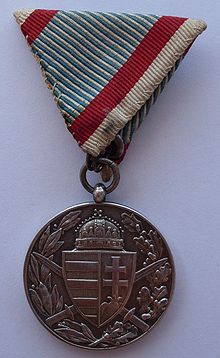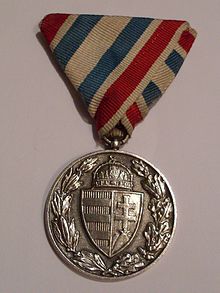Hungarian World War II Commemorative Medal


The Hungarian World War commemorative medal ( hu. Magyar háborús Emlékérem ) was on 26 May 1929 Regent Miklos Horthy donated and was intended to award those during the First World War fought or at the front in the home is the care and maintenance of wounded or prisoners of war.
Appearance
The award is a round medal made of tombac with a diameter of 31 mm and shows the large coat of arms of Hungary towered over by the St. Stephen's crown . An oak (left) and a laurel branch (right) with small fruits can be seen all around. In the center of the reverse the year 1914-1918 and in the upper semicircle the inscription PRO DEO ET PATRIA (For God and Fatherland). The lower semicircle is adorned with two palm branches tied together.
Front fighters received the award with two crossed side guns under the coat of arms and a steel helmet above the year.
The medal without swords was awarded to people who had successfully worked in the interests of the war wounded, sick or prisoners of war; the war widows and war orphans and those individuals whose relatives Family Holders or descendant of a straight line as a result of war wound or suffered in the field health damage had died; bourgeois persons who during the war, including up to October 30, 1918, performed state service or an equivalent service in the army in the field or in the rearward army area and through this activity contributed to the advancement of the interests of the armed forces (administration, post, telegraph, Railways, shipping, war industries, etc.).
Carrying method
From the triangle tape on which the medal was worn on the left chest, there were two ways: For front-line fighters, it is a white band with a wide median strip, the horizontal green-red-white is ribbed and is surrounded by a red side stripes. Non-fighters received the award on a white ribbon with two green central stripes and a red side stripe.
literature
- Ágnes Makai, Vera Héri: Kereszt, Érem, Csillag. Kitüntetések a magyar történelemben. Helikon Kiadó 2002.
